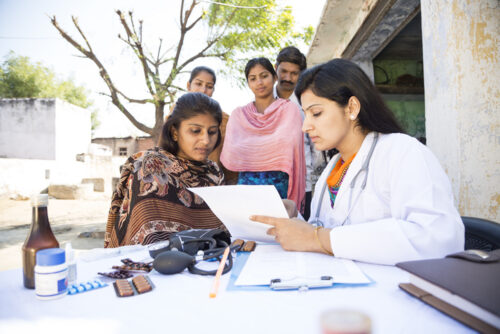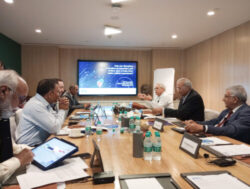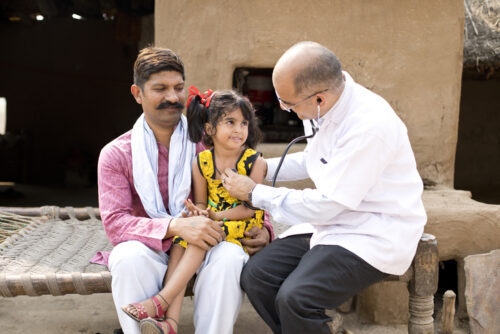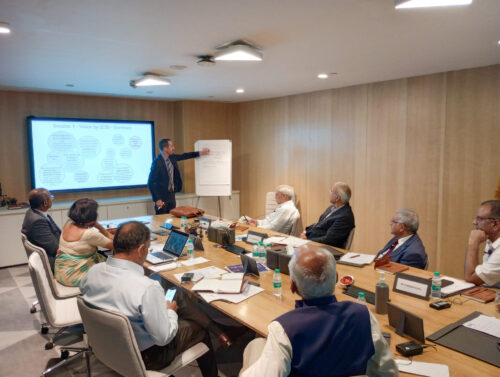
Transforming healthcare in India: driving disruptive innovation for better patient experience in secondary and tertiary care
Specialist roundtable on disruptive innovation in secondary and tertiary care in India
Our partnerships and events team regularly host roundtables that bring together international experts to outline, discuss and direct the conversation toward overcoming common clinical challenges.
We delivered a specialist roundtable in New Delhi with senior leaders to explore “how disruptive innovation of secondary and tertiary care in India drive better patient experiences.” The participants were primarily from the government, private sector, hospital and professional associations and key representative bodies, attended.


Kindly supported by Pristyn Health for educational purposes, the roundtable delivered:
📢 A gathering of stakeholders from government, hospitals, patient organisations, and technology startups to convene on critical healthcare topics.
🚀 A chance to explore and pinpoint challenges and opportunities for disruptive innovations in secondary and tertiary care.
💡 A space to showcase real-world examples of successful innovations to improve patient care.
🗣️ An expertly facilitated discussion that resulted in actionable recommendations for rapidly advancing towards world-class, affordable healthcare by 2030.
Key challenges in India’s healthcare system
As India strives to offer world-class, affordable care for its 1.4 billion citizens, it faces critical challenges in healthcare infrastructure, workforce capacity, and affordability. The World Health Organization recommends that there be 2.5 doctors for every 1000 patients.
In India, less than a quarter of doctors (0.7 per 1,000 patients) and a sixth of hospital beds are available (0.5 compared to 3.0 per 1,000 people). India needs innovative approaches to address this challenge more rapidly. Demand and supply gaps in secondary and tertiary care exist as up to 60% of health facilities are concentrated in a handful of large cities nationwide.
Presently, 30%- 35% of patients in India undergo surgery compared to 60%- 65% globally. Similarly, only 15%- 20% of patients in India undergo radiation therapy compared to 40%- 50% globally. The need for innovative solutions has never been more critical.
India’s healthcare infrastructure faces urgent pressure. With a shortage of trained doctors (0.7 per 1,000 patients, far below the WHO recommendation of 2.5) and insufficient hospital beds (0.5 per 1,000 patients compared to the global average of 3), it’s clear that innovation is needed. This imbalance is particularly acute in rural areas, where up to 60% of health facilities are concentrated in large cities. The need for innovative solutions has never been more critical.
Drivers of growth
Expanding initiatives like Ayushman Bharat (PM-JAY) will boost requirements for healthcare personnel in larger cities and Tier 2 and Tier 3 towns and villages. India will therefore need to increase the numbers of trained health personnel across various categories to achieve a ratio of at least 2.5 doctors and five nurses per 1,000 people by 2034.
Emerging technologies can assist delivery of more efficient and affordable patient care but to truly reach all of India’s population requires more than telehealth or digital healthcare apps. Innovative approaches are needed to overcome historical financial, geographic and social barriers to healthcare access; tackle health structures weighted towards secondary and tertiary care; to build capacity despite workforce shortages and limited rural infrastructure.


Key insights & takeaways
-
Expanding workforce capacity: India needs to rapidly scale its healthcare workforce, aiming for 2.5 doctors and five nurses per 1,000 people by 2034, in response to growing demands from initiatives like Ayushman Bharat.
-
Leveraging emerging technologies: While digital health solutions like telehealth are important, they cannot fully address India’s diverse needs. We must look beyond digital solutions to tackle financial, geographical, and social barriers.
-
Driving innovation from within: Panel discussions revealed a strong need for a cultural shift towards innovation within the Indian healthcare system. Dr Shubnum Singh highlighted how fostering a culture of innovation across all public and private sectors is crucial for driving long-term change.
-
Private sector’s role: Dr K Madan Gopal discussed how the private sector will be a key player in advancing healthcare innovation, particularly in the next decade.
The panel: visionary leaders driving change
- Dr Indu Bhushan – Ex-CEO Ayushman Bharat (Co-Chair)
- Dr Ashley McKimm – Editor-in-Chief, BMJ Innovations (Co-Chair)
- Dr Atul Mohan Kochhar – CEO, NABH
- Dr Ashok Grover – Chairman, Vision Eye Center, Sir Ganga Ram Hospital
- Dr Giridhar Gyani – Director General, AHPI
- Dr K Madan Gopal – Senior Advisor, Health, Niti Aayog
- Dr Mahesh C Mishra – Ex-Director, AIIMS, HOD General Surgery
- Dr Shubnum Singh – Advisor, Health – CII, Consultant Emeritus – Max Healthcare
- Dr Vijay Agrawal – President, CAHO, Advisor to Max Healthcare
- Darshan Pandit – BU Head – Sponsorship Sales


Moving forward: Practical steps for achieving India’s healthcare vision
Our roundtable concluded with a clear focus on actionable steps:
- Increasing healthcare personnel in both urban and rural areas.
- Fostering cross-sector partnerships to drive scalable innovations.
- Investing in digital solutions to reach underserved populations.
The experts and stakeholders are committed to working together to help India overcome its healthcare challenges to deliver world-class, affordable care for all by 2030.
“While we have the Centre of Excellence and Pan India, we need to raise the level of quality at the grass root levels and go back to the basics.”
Dr Atul Mohan Kochhar
Chief Executive Officer, National Accreditation Board for Hospitals & Healthcare Providers (NABH), A Constituent Board of Quality Council of India
“How can disruptive innovation of secondary and tertiary care in India drive better patient experience?”
Dr Indu Bhushan, Ex CEO Ayushman Bharat (Co-Chair) summarises what has been achieved in the health sector over the past 25 years.
Part 1
Dr Indu Bhushan speaks about their vision and what they need to do to achieve these goals.
Part 2





